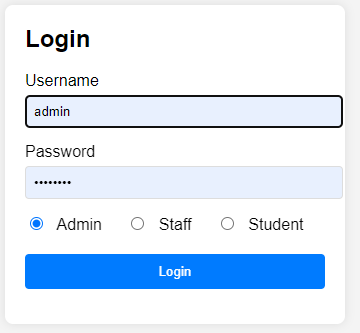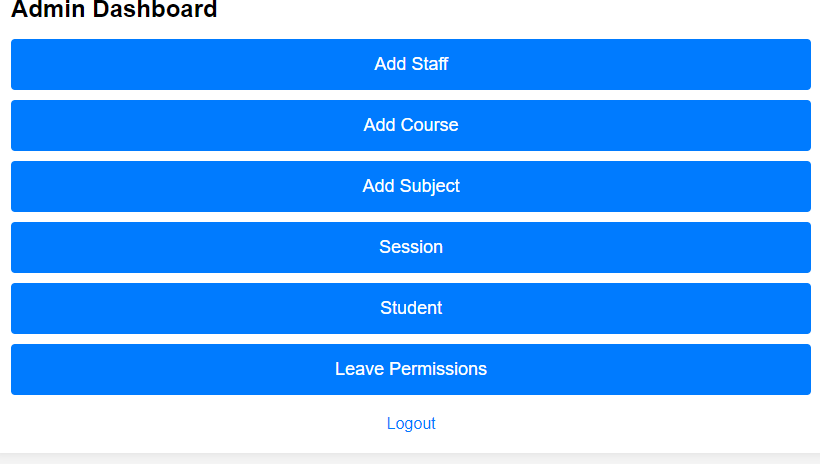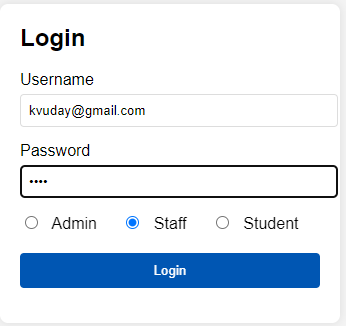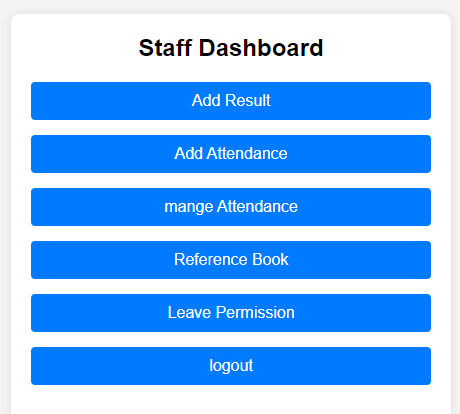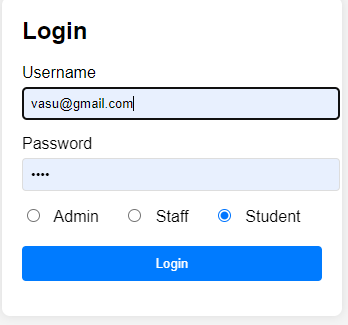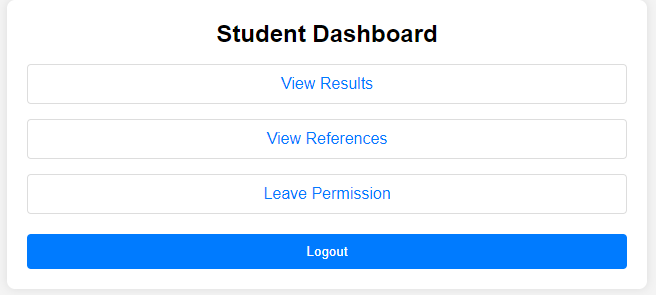Ijraset Journal For Research in Applied Science and Engineering Technology
- Home / Ijraset
- On This Page
- Abstract
- Introduction
- Conclusion
- References
- Copyright
Academic Anatomy of Higher Education
Authors: Rakesh T, Uday K V, Vasudendra , Venkat Dinesh Reddy
DOI Link: https://doi.org/10.22214/ijraset.2025.66665
Certificate: View Certificate
Abstract
The Academic Anatomy of Higher Education is an advanced digital platform that integrates and automates key administrative and academic processes within educational institutions. It provides a seamless interaction between administrators, faculty, and students, facilitating efficient management and communication. The system empowers administrators to manage staff recruitment, course and subject creation, student enrolment, and handle leave permissions. With this system, faculty members can easily manage student attendance, input academic results, and upload reference materials, providing a centralized source of academic data. Students benefit from quick access to their academic performance, attendance records, and available reference books. This unified platform streamlines administrative workflows, reduces manual intervention, and improves accuracy in tracking academic data. It promotes transparency and accountability across all levels of the institution, enhancing the overall academic experience. The system not only optimizes administrative tasks but also enables a more organized and collaborative learning environment. Through its comprehensive functionality, the Academic Anatomy of Higher Education ensures a more efficient, transparent, and user-friendly academic management system, ultimately contributing to better institutional performance and student satisfaction
Introduction
I. INTRODUCTION
The management of academic institutions involves a multitude of processes that span across various domains such as administration, teaching, and student services. As educational institutions grow in size and complexity, these processes become more difficult to manage manually, leading to inefficiencies, errors, and a lack of transparency. Traditional systems often struggle to integrate data across departments, which makes it challenging for administrators, faculty, and students to access important information in a timely manner.
The Academic Anatomy of Higher Education is a comprehensive digital platform designed to address these challenges by providing an integrated solution that connects administration, staff, and students. This system offers a unified platform where administrative tasks like staff recruitment, course creation, subject management, and leave approval are streamlined, reducing the burden on institutional resources. It ensures that faculty members can efficiently manage their responsibilities, including inputting results, tracking attendance, and uploading reference materials, thereby simplifying the academic workflow.
For students, this platform serves as a gateway to their academic journey. It allows them to access essential resources such as their results, attendance records, and reference books, which fosters a more engaging and informed learning experience. The system ensures real-time updates and better communication among all parties involved, promoting collaboration and transparency across the institution. In an era where technology plays a pivotal role in shaping education, the Academic Anatomy of Higher Education system empowers institutions to improve operational efficiency, enhance academic performance, and foster an environment of transparency and accountability. By automating administrative tasks and providing easy access to vital academic information, this platform plays a crucial role in supporting the academic community and enhancing the overall educational experience.
II. LITERATURE REVIEW
The author [1] Admission Policies: Institutions, with the leeway granted by academic autonomy, have the prerogative to delineate their admission guidelines, encompassing standardized test prerequisites, GPA benchmarks, and application protocols. In conclusion, admission protocols in autonomous institutions present a unique opportunity to foster academic excellence and cultivate a diverse and inclusive learning environment. By moving beyond standardized tests and embracing holistic assessments that consider a wider range of factors, such as creativity, leadership, and social impact, autonomous institutions can identify and admit students who possess the intellectual curiosity, resilience, and character necessary to thrive in a challenging and ever-evolving academic landscape. (Brown, 2021).
Assessment and Evaluation: Teachers shoulder the responsibility of creating assessment methods and evaluating student performance. With autonomy, they can craft assessments that align with their course objectives, offering constructive feedback to their students (Brown, 2021).
The author [2] Lack of Alignment with Educational Goals: Teacher autonomy might sometimes deviate from the broader educational objectives set by education regulators. In conclusion, aligning autonomy with educational goals requires a delicate balance. While fostering student independence and agency is crucial, it must be carefully guided to ensure that students develop the knowledge, skills, and critical thinking abilities necessary for success. By establishing clear learning objectives, providing appropriate support and guidance, and creating a culture of collaboration and accountability, educators can harness the power of student autonomy to achieve ambitious educational goals (Clarke, 2022).
The author [3] Introduced the Time Management Issues: Teachers, while enjoying autonomy, might find them overwhelmed with planning, leading to potential burnout In conclusion, while autonomy offers significant benefits for student learning and engagement, it also presents the challenge of effective time management. Students must learn to prioritize tasks, manage distractions, and utilize their time effectively to achieve their academic goals. Educators play a crucial role in guiding students in developing these essential time management skills, fostering a supportive learning environment, and helping students navigate the potential pitfalls of excessive autonomy. (Fischer, 2022).
The author [4] Teacher autonomy is a multifaceted construct with significant implications for student learning, teacher well-being, and the overall effectiveness of the education system. By understanding the dimensions, benefits, and challenges of teacher autonomy, educators and policymakers can work together to create supportive environments that empower teachers and enhance student learning outcomes.
The author [5] Introduced the cultivating autonomous classrooms requires a nuanced approach to managing student expectations. By clearly communicating the principles of autonomy, fostering open dialogue, and providing ongoing support and guidance, educators can empower students to take ownership of their learning while ensuring that academic rigor and accountability are maintained. Ultimately, meeting expectations in autonomous classrooms hinges on the teacher's ability to shift from a traditional, directive role to that of a facilitator and mentor. By establishing clear boundaries, providing timely feedback, and cultivating a culture of trust and mutual respect, teachers can create an environment where students thrive in their autonomy while achieving their academic goals. Meeting expectations in autonomous classrooms is an ongoing process that requires continuous adaptation and refinement. By regularly assessing student progress, gathering feedback, and adjusting teaching practices accordingly, educators can create a dynamic and responsive learning environment that fosters both student autonomy and academic success.
The author [6] Introduced this research underscores the critical link between teacher autonomy and retention. By empowering teachers with greater control over their professional practice, including decision-making power in areas such as curriculum development, instructional methods, and professional development, educational institutions can significantly enhance teacher job satisfaction and reduce turnover rates. Fostering a culture that values teacher autonomy not only benefits individual educators but also contributes to a more stable and effective teaching force, ultimately improving student learning outcomes.
The author[7] Cultivating critical thinking skills is paramount in the age of autonomy. As individuals navigate an increasingly complex and interconnected world, they must be equipped to evaluate information critically, solve problems independently, and make informed decisions. Education systems must prioritize the development of these essential skills to empower individuals to thrive in this era of unprecedented freedom and responsibility. While the age of autonomy presents exciting opportunities, it also poses significant challenges. The abundance of information, the proliferation of misinformation, and the rapid pace of change demand a high level of critical thinking. Educators must adapt their teaching methods to foster these skills, encouraging students to question assumptions, analyze evidence, and develop their own informed perspectives. Ultimately, education plays a crucial role in preparing individuals for the age of autonomy. By fostering a love of learning, cultivating intellectual curiosity, and equipping students with the critical thinking skills they need to navigate a complex world, educators can empower individuals to become responsible, informed, and engaged citizens.
The author[8] Building bridges between students and teachers in autonomous learning environments requires a shift in the teacher's role. From being the primary source of knowledge, the teacher becomes a facilitator, mentor, and guide. By fostering open communication, building trust, and providing personalized support, teachers can nurture strong student-teacher connections that are essential for student success in these dynamic learning environments. Despite the increasing emphasis on technology and independent learning, the human connection between student and teacher remains vital. In autonomous environments, this connection evolves, becoming more nuanced and personalized. By prioritizing empathy, understanding, and genuine care for each student, teachers can create a supportive and nurturing learning environment that fosters both academic and personal growth. Strong student-teacher relationships are essential for fostering a positive and productive learning environment, regardless of the educational approach. In autonomous environments, these relationships are particularly crucial. They provide students with the emotional support, guidance, and motivation they need to navigate challenges, embrace independence, and achieve their full potential.
The author [9] Academic autonomy presents both significant challenges and substantial rewards for teachers. While navigating increased independence can be daunting, the benefits of greater control over one's teaching practice are numerous, including increased job satisfaction, enhanced student engagement, and the opportunity to foster a more personalized and meaningful learning experience. By providing adequate support, fostering a culture of collaboration, and addressing the potential challenges proactively, educators can harness the power of academic autonomy to improve teaching and learning outcomes for all.
The author [10] The 21st century demands a dynamic approach to curriculum design. Rigid, static curricula are ill-equipped to prepare students for the complexities of our rapidly changing world. By embracing flexibility, adaptability, and a student-centered approach, educators can create learning experiences that are relevant, engaging, and truly prepare students for success in the 21st century. Technology has revolutionized the way we learn and access information. Dynamic curricula must leverage these technological advancements to create personalized learning experiences, foster creativity and innovation, and prepare students for the digital age. By integrating technology seamlessly into the curriculum, educators can create a more engaging and effective learning environment for all students. The development of dynamic curricula is an ongoing process that requires continuous evaluation, reflection, and adaptation. Educators must regularly assess the effectiveness of their curricula, gather student feedback, and make adjustments based on the evolving needs of students and society. By embracing a culture of continuous improvement, educators can ensure that their curricula remain relevant, engaging, and effective in preparing students for the challenges of the 21st century.
III. MODULE DESCRIPTION
The proposed system is built using multiple modules:
A. Admin Functions
1) Add, Update, and Remove Staff Profiles
- Admin can create new staff profiles by entering essential details such as name, designation, department, contact information, and credentials.
- Admin can update existing staff profiles, modifying details like address, phone number, role, or department when required.
- Admin can also remove staff profiles upon resignation, retirement, or termination.
2) Add, Update, and Remove Student Profiles
- Admin can create student profiles with details like name, roll number, class, contact information, and enrollment status.
- Admin can update student profiles to reflect changes such as course updates, personal details, or academic progress.
- Admin can delete student profiles for students who have graduated, withdrawn, or are no longer enrolled.
3) Create New Courses and Subjects
- Admin can design new courses by specifying details like course title, syllabus, duration, and associated subjects.
- Admin can also create individual subjects linked to specific courses.
B. Staff Functions
1) Result Management
Enter Student Results
- Faculty can input students’ scores for various assessments such as assignments, quizzes, exams, and projects.
- Results can be entered subject-wise or course-wise and saved securely.
Update and Manage Results
- Staff can update previously entered results in case of re-evaluations, corrections, or missed entries.
- Results are organized systematically, allowing for efficient searching and editing.
2) Attendance Management
Record Student Attendance
- Faculty can mark attendance daily or for specific sessions, lectures, or labs.
- Attendance can be recorded for individuals or bulk entries for an entire class.
Track Attendance Trends:
- Attendance records can be analyzed to track students’ attendance trends over time.
- This feature helps identify regular absentees or students at risk of falling below attendance requirements.
3) Reference Material
Upload Reference Books and Materials
- Faculty can upload digital materials such as e-books, PDFs, presentation slides, and lecture notes.
- Materials can be tagged with relevant subjects or topics for easy categorization.
C. Student Functions
1) Result Viewing
Access Personal Results
- Students can log in to their accounts to view their academic results for all assessments and exams.
- Results are displayed in an organized manner, showing individual scores, grades, and total marks for each subject.
- Students can track their performance trends over time, comparing scores from previous semesters or assessments.
Track Academic Progress
- Students can track their performance trends over time, comparing scores from previous semesters or assessments.
- Visualizations like graphs or progress charts can provide an intuitive understanding of their academic trajectory.
2) Reference Material
View Reference Materials
- Students can access reference books, lecture notes, and other materials uploaded by the faculty.
- Resources are organized by subjects, making it easy for students to find materials relevant to their courses.
Download Materials
- Students can download materials for offline use, ensuring they can study without needing continuous access to the internet.
- Download options can include single files or entire folders, depending on the resource structure.
IV. RESULTS AND EVALUATION
Conclusion
In conclusion, the Academic Anatomy of Higher Education system offers a much-needed solution to the complex challenges faced by modern educational institutions in managing academic and administrative tasks. By integrating key functions such as staff management, course creation, student enrolment , leave approval, attendance tracking, and resource management into a single, streamlined platform, the system ensures improved efficiency, accuracy, and transparency. It not only reduces the administrative burden on faculty and staff but also provides students with real-time access to their academic progress, attendance, and reference materials.
References
[1] Brown, S. (2021). Admission Protocols in Autonomous Institutions. Education Strategy Quarterly. Elite Publications, Chicago. [2] Clarke, M. (2022). Aligning Autonomy and Educational Goals. International Journal of Pedagogical Research. City Press, Boston. [3] Fischer, K. (2022). Time and Autonomy: The Double-edged Sword. Modern Teaching Chronicles. Peninsula Press, San Diego. [4] Gomez, E. (2021). The Autonomy Framework: Supporting Educators. Latin American Education Review. South Press, Buenos Aires. [5] Hughes, L. (2020). Meeting Expectations in Autonomous Classrooms. North American Journal of Education. Peak Publishers, Toronto [6] Johnson, F. (2021). The Connection Between Autonomy and Retention. Teacher’s Voice Quarterly. University Publishers, Melbourne [7] Jones, L. (2019). Critical Thinking in the Age of Autonomy. Global Education Insights. Scholars Publishing, London. [8] Kim, Y. (2020). Building Bridges: The student-Teacher Connection in Autonomous Environments. Asian Pedagogical Journal. Unity Publishers, Tokyo [9] Lewis, T. (2018). Academic Autonomy: Challenges and Rewards. Teacher’s Monthly Review. Educators Publishing, Boston. [10] Martinez, P. (2019). Dynamic Curricula in the 21st Century. Latin Pedagogy Review. Horizon Publications, Santiago.
Copyright
Copyright © 2025 Rakesh T, Uday K V, Vasudendra , Venkat Dinesh Reddy. This is an open access article distributed under the Creative Commons Attribution License, which permits unrestricted use, distribution, and reproduction in any medium, provided the original work is properly cited.

Download Paper
Paper Id : IJRASET66665
Publish Date : 2025-01-24
ISSN : 2321-9653
Publisher Name : IJRASET
DOI Link : Click Here
 Submit Paper Online
Submit Paper Online



